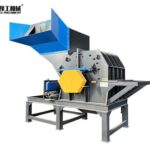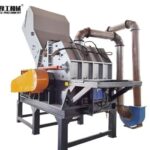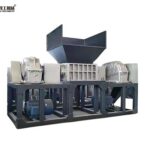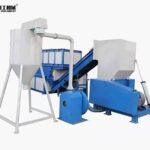Industrial metal shredder is a heavy-duty machine engineered to reduce large metal objects into smaller fragments. These fragments can then be sorted, recycled, or repurposed, minimizing waste and maximizing resource efficiency. Industrial metal shredding machines are capable of handling diverse materials, including steel, aluminum, copper, brass, and even mixed metals, making them indispensable in industries such as automotive manufacturing, construction, scrap metal recycling, and electronics disposal.
Components And Working Mechanism
Feeding System: A conveyor belt or hydraulic pusher that feeds raw materials into the industrial metal shredder chamber.
Shredding Chamber: Equipped with rotating blades or hammers that tear, cut, and crush metal into smaller pieces.
Drive System: A high-torque motor or diesel engine that powers the shredding process.
Screening System: Filters output material to ensure consistent particle size.
Discharge System: Transports shredded material to collection points or further processing stages.
Types Of Industrial Metal Shredders
Single-Shaft Shredders
Single-shaft shredders use a single rotating rotor with blades to process materials. They are ideal for medium-duty applications, such as shredding thin metal sheets, wires, or small automotive parts. Their compact design suits facilities with limited space.
Dual-Shaft Shredders
Dual-shaft shredders feature two interlocking rotors that rotate in opposite directions. This design enhances shredding efficiency and torque, enabling the machine to handle thicker metals, appliances, or entire vehicles. Dual-shaft models are widely used in large-scale recycling plants.
Principle of A Shredding Machine for Metal
Feeding Mechanism: Scrap metal is fed into the industrial metal shredder via a conveyor or manual input system.
Shredding Chamber: Inside the chamber, rotating shafts with hardened steel blades apply shearing, tearing, and compressing forces to break down the material.
Size Reduction: The material is reduced to smaller pieces based on the machine’s screen or grate specifications.
Output and Collection: Shredded metal is discharged from the machine and collected for further processing, sorting, or recycling.
Benefits of Using an Industrial Metal Shredder
- Volume Reduction
Shredders significantly reduce the volume of metal waste, making storage and transportation more economical. Compact shredded materials are easier to handle and require less space. - Enhanced Recycling Efficiency
By breaking down metals into smaller pieces, shredders facilitate easier sorting and separation. This enhances recycling rates and ensures higher purity of recovered metals. - Environmental Sustainability
Using an industrial metal shredder helps minimize waste sent to landfills. This promotes eco-friendly operations and supports compliance with environmental regulations.






